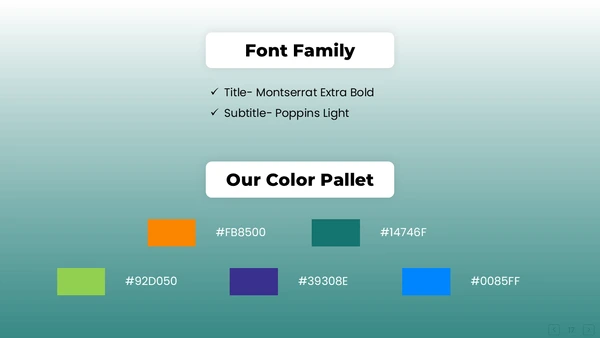Prepare to impress your audience with our comprehensive Brand Positioning Presentation PPT! This adaptable set of slides is available in PowerPoint, Canva, and Google Slides formats, making it perfect for any context—whether you’re presenting at a corporate event, conducting a marketing workshop, or pitching ideas to investors.
Table of Content
- Introduction
- What is Brand Positioning?
- Why Brand Positioning Matters?
- Components of Brand Positioning
- Steps to Create a Brand Positioning Strategy
- Types of Brand Positioning Strategies
- Positioning Statement Examples
- Positioning maps and competitive analysis
- Case study: Successful brand positioning
- Common positioning challenges and solutions
- Future trends in brand positioning
- Conclusion & Key Takeaways
Grab the Brand Positioning Presentation Available for PowerPoint, Google Slides, or Canva
Our user-friendly templates allow for quick modifications to colours, images, fonts, and icons, ensuring your presentation is uniquely yours. Let’s take a closer look at each slide and discover their benefits in enhancing your Brand Positioning presentation.

This slide on Brand Positioning PPT Defines brand positioning, its core idea, and its purpose.
What is Brand Positioning? (Slide 04)

Definition
Brand Positioning is a planned method in which a brand is deliberately placed in customers’ minds. The aim is to build a distinct impression and identity for the brand compared to competitors.
What does your brand stand for?
The questions outline the brand’s identity values and mission. They explain the fundamental aim and commitment. The brand intends to deliver to its customers, and understanding what the brand represents helps build a sentimental bond with the audience.
How is it different?
This concentrates on distinction, which is crucial in terms of positioning in a competitive market. It includes identifying and communicating the unique elements of the brand, regardless of its superior quality, innovative features, exceptional service, or specific client, that no other competitor offers in the same way.
Purpose of Brand Positioning
The brand positioning aims to develop a distinct, uniform, and appealing impression of the brand that aligns with the target market. By establishing this concept businesses ensure that their audience understands the brand’s unique value, proposition making it easier for the customers to choose them over competitors.
Brand Positioning forms the base for every marketing and communication plan, ensuring that every engagement or message is aligned with the brand’s core identity and uniqueness. This eventually influences customer perception and helps Brands build a strong, loyal customer base.
For insight into Brand Management, You can visit and download Brand Management PPT
This slide on Brand Positioning PPT will help you establish a foundational understanding of brand positioning for the audience.
This slide on Brand Positioning Templates Highlights the significance of brand positioning in business strategy.
Why Brand Positioning Matters? (Slide 05)

Brand positioning is a vital element of an effective business strategy. It shapes how customers perceive a brand and defines its place in the market. A strong brand positioning not only sets apart the brand from its competitors but also builds loyalty and long-term value.
- Clarity
Brand Positioning offers clarity to customers about what the brand offers and why it is unique. It communicates the brand’s fundamental values, benefits and what sets it apart making it easier for customers to understand and connect with the brand.
- Customer Preference:
A strategically placed brand creates a convincing reason for customers to prefer it over competitors.
- Market Differentiation
In a crowded and competitive market differentiation is essential. Brand Positioning helps build a unique space for the brand ensuring it distinguishes itself and attracts the focus of the target audience.
- Premium Pricing
Brands that effectively build a strong and desirable positioning can justify charging higher prices. Customers are often ready to spend extra for a brand they regard as of high worth, elite, or superior.
Purpose of Emphasizing Brand Positioning
The aim of showcasing the significance of brand positioning is to illustrate how it leads to business growth. It plays a crucial role in shaping customer views increasing loyalty and eventually improving profitability.
This slide on Brand Positioning Templates will help you Reinforce the rationale for investing in brand positioning and Provide persuasive points to advocate for brand strategy to stakeholders.
This slide on Brand Positioning PowerPoint Templates Breaks down the essential elements of brand positioning.
Components of Brand Positioning (Slide 06)

Effective brand positioning depends on various important elements that operate together to build a strong, clear, and memorable identity in the market. Each component plays a crucial role in ensuring the brand merges with its target audience and sets itself apart from its competitors.
- Target Audience
This defines the specific category of individuals that the brand aims to serve. Understanding the target audience’s demographics, needs, preferences and behaviours remains essential to creating messages and products that appeal directly to them.
- Value Proposition
The value proposition is the unique value that a brand promises to offer its customers. It is a clear statement that clarifies why the brand is the best option and what benefits it offers that others do not.
- Competitive Advantage
This component highlights what makes the brand superior compared to its competitors. It could be related to product quality, innovation, customer service, price or other unique features.
- Brand Promise
The brand promise is a brief statement of commitment that the brand makes to its customers. It outlines what the brand consistently delivers and sets standards for the customer experience.
Purpose of Understanding These Components
The purpose of breaking these fundamental elements is to provide a clear framework for effective brand positioning by concentrating on these aspects businesses can develop a comprehensive positioning strategy that aligns with their goals, merges with their target audience and sets them apart from their competitors.
This slide on Brand Positioning PowerPoint Templates will help you offer a structured framework for developing brand positioning.
This slide on Brand Positioning Presentation contains Details and a step-by-step guide for developing a brand positioning strategy.
Steps to Create a Brand Positioning Strategy (Slide 07)
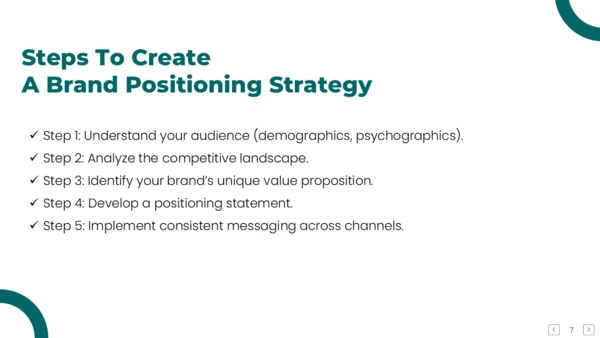
Creating a strong brand positioning strategy is crucial for creating a clear identity and competitive advantages in the marketplace.
Step1
- Understand your audience
Demographics
Gather information about age, gender, income education, and location in order to define who your audience is.
Psychographics
Dive deeper into the audience’s interests values lifestyle and behaviours. Understanding these aspects helps create a more tailored method for positioning your brand.
Step2
- Analyze the Competitive Landscape
Conduct a detailed analysis of competitors within your industry. Identify their strength, weaknesses, positioning strategies and market share.
Step3
- Identify Your Brand’s Unique Value Proposition
Identify what makes your brand unique and what specific benefits, features or attributes set it apart from the competitors. This value proposition should align with your target audience.
Step4
- Develop a Positioning Statement
Craft a clear and to-the-point positioning statement that summarizes your brand identity. Target audience, unique value proposition and competitive advantages. A strong positioning statement serves as a guiding structure for all branding and marketing efforts.
Step5
- Implement Consistent Messaging Across Channels
Ensure that every marketing resource’s communications and brand engagements consistently represent the positioning strategy. This includes visual branding messaging tone and customer service methods.
Purpose of This Step-by-Step Guide
This step-by-step guide provides an organized method for developing a brand positioning strategy by following these steps businesses can effectively identify their unique place in the market with their target audience.
This slide on Brand Positioning Presentation will help you Provide a clear action plan for the audience to follow.
This slide on Brand Positioning PPT Outlines different positioning strategies brands can adopt.
Types of Brand Positioning Strategies(Slide 08)
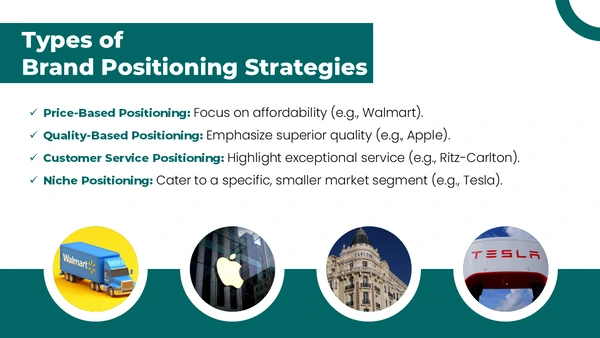
Different brands use various positioning strategies to set their unique position in the market.
- Price-Based Positioning
This strategy focuses on cost-effectiveness and value for money. Brands using this approach highlight low prices as a primary selling point.
Walmart is a leading example positioning itself as the go-to retailer for customers seeking low prices on everyday items. Their marketing highlights savings and value for money attracting budget shoppers.
- Quality-Based Positioning
Brands adopting this approach highlight superior quality skills or premium features. The aim is to provide exceptional products or services that justify a higher price.
Apple represents quality-based positioning by promoting its innovative design and user experience. The brand conveys a sense of luxury and status drawing customers willing to spend more for recognized quality.
- Customer Service Positioning
This approach emphasizes exceptional customer service as a key differentiator. Companies using this approach aim to create a positive experience that drives customer loyalty and word of mouth.
Ritz-Carlton is known for outstanding customer service, with personal attention and a commitment to exceeding guest expectations being key elements of this brand This positioning attracts customers who value a superior service experience.
- Niche positioning
Description: Niche positioning involves addressing a specific, narrow market with customized offerings. Companies using this approach focus on unique needs or preferences that larger competitors often overlook.
Tesla operates in a unique market for electric vehicles, targeting environmentally conscious customers who are looking for innovative and sustainable transportation solutions. By focusing on this specific audience, Tesla has differentiated itself in the automotive industry.
Purpose of Outlining These Strategies
By defining these strategies for branding, businesses can evaluate which strategy best aligns with their goals, audience, and marketplace Each strategy offers unique value and can be leveraged to create a strong brand identity that resonates with customers, Ultimately driving brand loyalty and success.
This slide on Brand Positioning PPT will help you Provide real-world examples to illustrate each strategy, enhancing relatability.
Positioning Statement Examples (Slide 09)

Creating effective positioning statements to showcase what the brand stands for and how it stands out in the marketplace. Below is an example of how to compose a concise and impactful position statement:
Example 1:
FreshSprout
For: A health enthusiast
Our logo: FreshSprout
Simply: a plant-based protein bar
She: Provides essential nutrients without sugar.
This statement effectively targets a unique audience (health-conscious individuals) highlights the brand’s unique selling proposition (a plant-based protein bar with essential nutrients and no sugar), and makes it stand out clearly why consumers should choose FreshSprout.
Example 2:
SkyLuxe
In: Travelers of luxury
Our brand: SkyLuxe
Give Personalized experiences that heighten travel enjoyment.
This positioning statement identifies a specific target market (luxury travellers) and emphasizes the brand’s focus on delivering personalized experiences that maximize comfort, setting Skylux apart from scheduled transportation services.
The purpose of these examples
This example shows how to create a clear and concise positioning statement that communicates the target audience, brand identity, unique offerings and benefits. A well-crafted positioning statement is foundational in branding and marketing efforts, guiding the overall messaging strategy and ensuring consistency of communication.
This slide on Brand Positioning Templates will help you demonstrate practical applications of theory, making concepts tangible.
This slide on Brand Positioning PowerPoint Templates Explains the use of positioning maps and competitive analysis.
Positioning maps and competitive analysis (Slide 10)
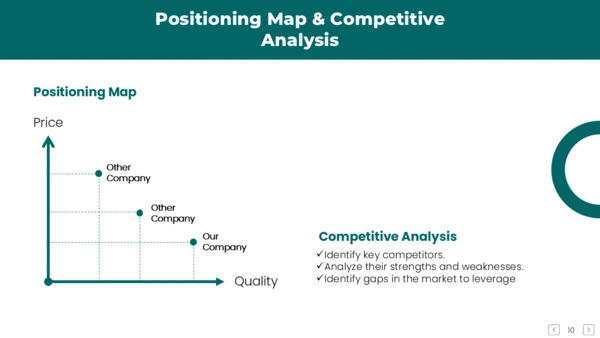
Understanding your brand position relative to competitors is essential to effective brand positioning. Position mapping and competitive analysis provide valuable insights into market trends and opportunities for differentiation.
- Position Map
A positioning map is a visual representation of where your brand stands about its competitors based on specific criteria. Common axes include price and quality, but other dimensions such as customer service and product assortment or innovation and tradition can also be used.
For example:
X-axis: Value (from low to high).
Y-Axis: Quality (Basic to Premium).
Each brand is mapped based on its perceived position in the market. This visualisation helps you see how your brand fits in with competitors or stands out more.
- Competitive Analysis
Identify major competitors
List the major competitors in your industry. This includes direct competitors (offering similar products or services) and indirect competitors (offering alternatives).
Analyze their strengths and weaknesses.
Look at what each competitor does well and where they fall short. This assessment can include things like product quality, pricing strategies, customer service, brand reputation, and marketing effectiveness.
Identify the gap in the market for leverage.
Look for areas where competitors don’t exist or can’t meet customer needs. This includes underserved market segments, failure to address customer pain points or unique features of products that can differentiate your brand.
The purpose of this program
Using positioning maps in conjunction with competitive analysis clarifies eyes and provides deeper insights into market opportunities. Understanding the competitive landscape, the brand
This slide on Brand Positioning PowerPoint Templates will help you Empower the audience with tools to assess their brand positioning and provide insights into market opportunities and strategic adjustments.
This slide on Brand Positioning Presentation Examines case studies of Nike and Starbucks.
Case study: Successful brand positioning (Slide 11)

Examining successful brand positioning case studies provides valuable insights into how effective strategies can lead to stronger market presence and customer loyalty. Below are examples of two prominent companies that have successfully positioned themselves in the market.
Nike
Nike has successfully established itself as an inspiring brand that emphasizes performance, innovation and athletic excellence. Through its powerful messaging and campaigns, especially the iconic “Just Do It,” Nike inspires individuals to push their limits and achieve their personal best
For a detailed insight into Nike, You can Visit Nike
Special Features
Emotional connection: Brands connect with customers by harnessing their aspirations and encouraging a sense of perseverance and achievement.
Innovation
Continued investment in research and development keeps Nike at the forefront of sports apparel technology, appealing to athletes and fitness enthusiasts.
Starbucks
Starbucks has created a niche as a premium coffee experience, focusing on atmosphere, quality products and exceptional customer service. The brand is known for its inviting storefronts that foster community and connectivity.
Special Features
Quality of Experience: Starbucks emphasizes high-end coffee and beverages, setting itself apart from other coffee shops with its well-crafted menu and experienced baristas
Customer Engagement
The brand builds loyalty through personalized service and the Starbucks rewards program, encouraging repeat visits and deeper relationships with customers.
Key Takeaways
Consistent messaging
Both Nike and Starbucks carry consistent messaging that is consistent with their brand identity, reinforcing their position in the market.
Customer understanding
A deep understanding of their target audience allows these companies to fine-tune their offerings and marketing strategies.
Emotional connection
Building an emotional connection with customers is important; In both cases, consumption through stories and relatable experiences inspires loyalty and engagement.
The purpose of this case study
This case study illustrates real-world success stories of effective brand placement. By analyzing how Nike and Starbucks found their positioning, businesses can gain insight into the strategies and principles of success in terms of brands, customer loyalty and market differentiation.
This slide on Brand Positioning Presentation will help you Highlight successful strategies in action, reinforcing concepts discussed earlier.
This slide on Brand Positioning PPT Identifies challenges in brand positioning and solutions.
Common positioning challenges and solutions (Slide 12)

Navigating the landscape of brand positioning can be fraught with challenges. Identifying these barriers and finding actionable solutions can help brands maintain a strong presence and build relationships with their audiences. Below are some of the most common challenges and possible solutions.
Challenge 1: Inconsistent messages
Implications
Inconsistent messaging can confuse consumers and weaken brand awareness, making it difficult for them to understand what the brand stands for.
Solution
Align all communications with the brand’s core message: Ensure that all marketing materials, advertising, social media posts, and customer communications reflect the brand’s core values and positioning. To stay consistent across platforms, create a brand style guide that outlines key tone, voice, and messages.
This slide on Brand Positioning Templates Discusses emerging trends in brand positioning.
Future trends in brand positioning (Slide 13)

As the market environment evolves, brands need to adapt their positioning strategies to remain relevant and meet changing consumer needs. Here are some of the key trends shaping the future of brand positioning.
- Personalization
Commentary
Personalisation becomes increasingly important as consumers demand tailored experiences tailored to their individual preferences and needs. Brands will need to leverage data and insights to create customized offers, communications and interactions.
Implications
Companies that invest deeply in understanding their customers and delivering personalized experiences will drive loyalty and increase customer satisfaction.
- Establishment of sustainability
Commentary
As environmental awareness increases, companies that position themselves as environmentally friendly will gain a competitive advantage. Consumers are choosing raw materials that show a greater commitment to sustainability and ethical practices.
Implications
Companies need to incorporate sustainable practices into their operational and marketing strategies, and effectively communicate their environmental policies to attract eco-conscious consumers.
- AI-powered search
Implications
The rise of artificial intelligence (AI) will enable brands to analyze vast amounts of data to better understand their audience’s behaviours, preferences and trends AI-powered insights will help brands refine and build their positioning strategies to the right decision.
Implications
Companies that embrace AI tools for market research, customer research and trend forecasting will be better equipped to position themselves and react faster to market changes.
Purpose of Highlighting These Trends
Encouraging thoughtful growth and adapting to future trends is essential to keeping brands relevant in an ever-changing marketplace. By recognizing and embracing these factors, companies can proactively adapt their positioning strategies to meet customer needs, enhance customer experiences, and achieve sustainable competitive advantage If adaptations to these processes are not only sustainable but pave the way for future growth and innovation.
This slide on Brand Positioning Templates will help you Encourage forward-thinking and adaptability in brand strategy.
This slide on Brand Positioning PowerPoint Templates Summarizes the importance of brand positioning.
Conclusion & Key Takeaways (Slide 14)
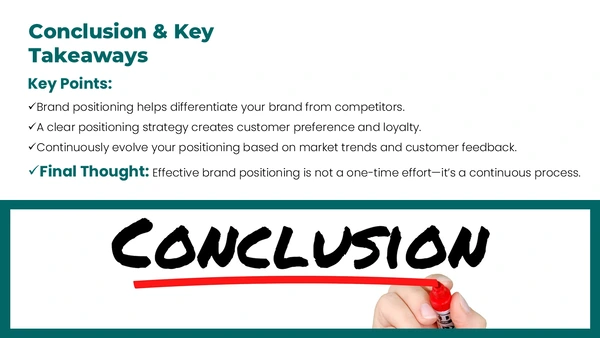
In conclusion, brand positioning is an important component of a successful marketing strategy that helps businesses stand out in a crowded market Here are the key points to remember:
Key Points
- Brand positioning helps set your brand apart from competitors
A well-defined positioning strategy sets your brand apart by emphasizing unique features and value propositions, making it easier for consumers to identify and choose your brand over others
- A clear positioning strategy for consumer preference and loyalty:
By communicating your brand personality and values effectively, you can create a stronger emotional connection with your audience. This relationship creates a likeable and loyal network, leading to frequent employment and word-of-mouth referrals.
- Continue to evolve your positioning based on market trends and customer feedback.
The market environment is dynamic, and consumer expectations are constantly changing. Regularly gathering information and monitoring industry trends will help adapt your positioning strategy to remain relevant and meet customer needs.
Final Thoughts
Establishing an effective brand isn’t a one-time effort—it’s an ongoing process. As consumer behaviour evolves and market conditions change, brands must be nimble and responsive, revising their positioning strategy to maintain their competitiveness and accommodate this ongoing journey to create a strong brand that resonates with customers and fosters long-term success.
This slide on Brand Positioning PowerPoint Templates will help you Reinforce the main messages of the presentation for better retention.
Our Brand Positioning PPT Template also includes supplementary slides that showcase the font family and colour palette used throughout the presentation. These additional slides provide clarity on the design choices, ensuring a cohesive and consistent visual experience. Additionally, we have included a dedicated Questions and Answers slide to facilitate further discussion and engagement on Brand Positioning topics.
The Brand Positioning Presentation Template is designed to enhance discussions on the principles and strategies of effective brand positioning. With 18 fully customizable slides, it covers crucial topics such as brand identity and messaging, strategy framework, target audience, customer experience, and managing brand equity. This template equips you with the tools to effectively communicate the importance of creating and maintaining a strong brand position.
Ideal for business workshops, marketing seminars, or educational sessions, this resource helps you engage and inform your audience with clarity and impact. Download it today in PowerPoint, Canva, or Google Slides formats to elevate your presentation effortlessly.


















